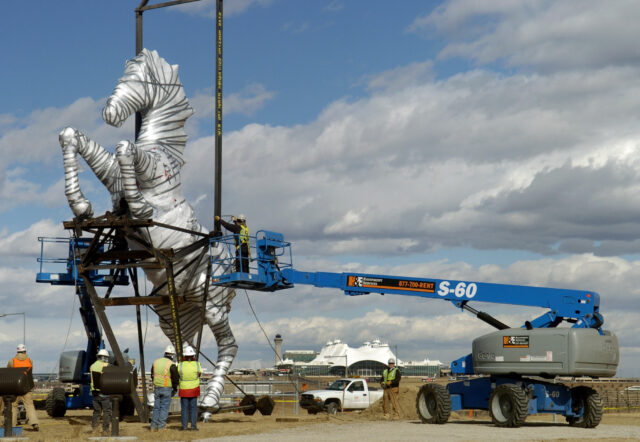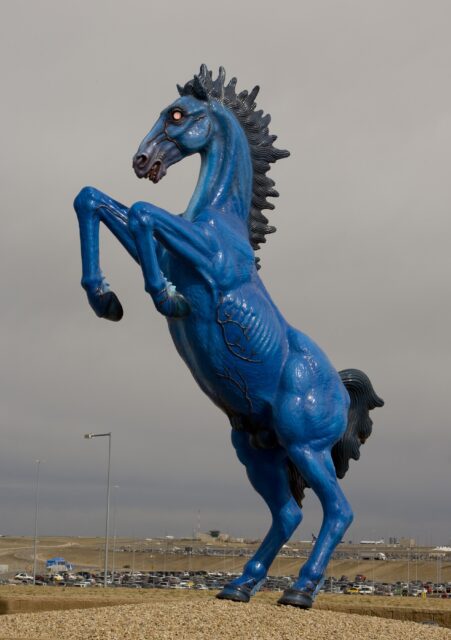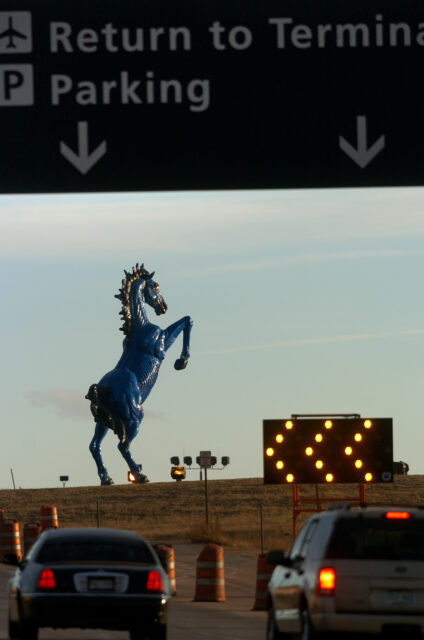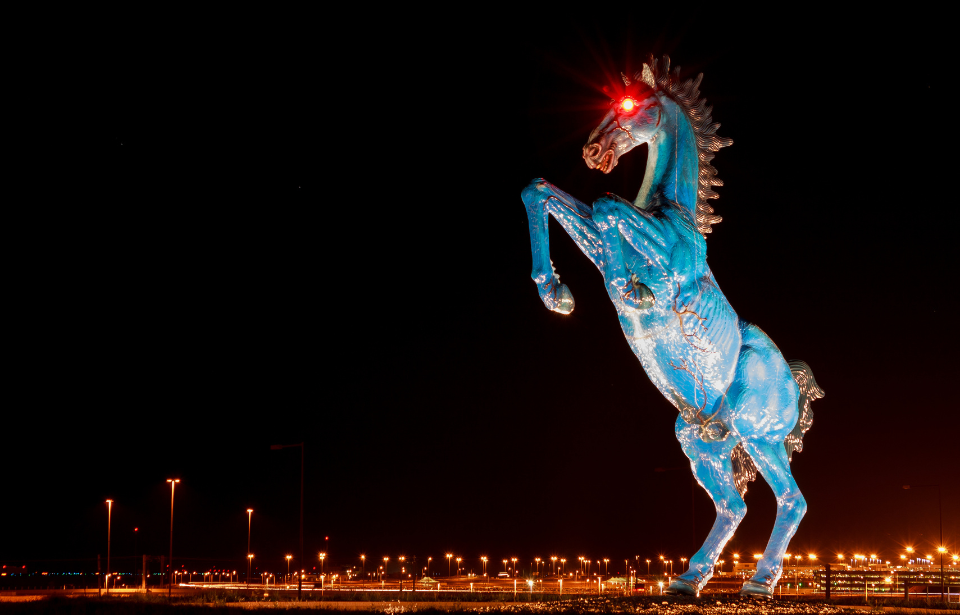Mustang, also known as Blue Mustang or Blucifer, is a striking sculpture of a rearing horse located at the entrance to Denver International Airport. Created by artist Luis Jiménez, the piece is made almost entirely of fiberglass and was installed in 2008. While the sculpture has become a notable landmark for the airport and the city of Denver, it has also garnered controversy and mixed reactions due to its intense, glowing red eyes and a fatal accident that occurred during its creation. Despite any negativity, Mustang remains an impressive and fascinating work of public art that captures the spirit of the American West.
The Denver International Airport wanted some artwork

In 1995, when the Denver International Airport (DEN) opened to the public, it was surrounded by criticism. Some were in favor of the airport opening, excited for the new business and tourism it might bring. Others felt that it was an unnecessary addition to the city, one that took too long to build and cost far too much, greatly exceeding the original budget.
Before the airport’s opening, the City of Denver felt that a sculpture representing the city should be erected at the site. So, in 1992, they commissioned artist Luis Jiménez with the task for $300,000. Originally, he proposed a buffalo stampede, but this was turned down as it was deemed inappropriate. He then replaced that idea with a mustang, which symbolized the West and coincided with the airport’s promise of long-distance travel.
Mustang seems to have taken inspiration from Jiménez’s life, and it’s also anatomically correct. It’s believed that the work was created in the likeness of Jiménez’s own blue roan Appaloosa named ‘Blackjack,’ which may explain his choice of the bright blue color. As well, a common characteristic of Jiménez’s artwork is the addition of glowing red LED eyes. Having grown up working at his father’s neon sign shop, Jiménez often added glowing red eyes to animal sculptures to honor his roots. This demonic-looking feature on Mustang earned it the nickname Blucifer shortly after it was unveiled.
Blucifer killed its maker

At 32 feet tall and weighing around 9,000 pounds, Blue Mustang was no easy feat to complete. Jiménez actually first created five smaller versions of the sculpture, four of which are held in private collections. The other has been part of the University of Oklahoma’s public collection since 1998.
The larger sculpture was built in three parts at his studio in Hondo, New Mexico. Jiménez had nearly completed Mustang when tragedy struck in 2006. He was working on the sculpture in his studio when one of the three sections came loose from its hoist. When it fell, it pinned Jiménez against a steel support beam and severed an artery in his leg. Stuck where he was, Jiménez sadly bled to death.
He was just 65 years old when he was declared dead upon arrival at the nearest hospital. Following his death, his friends and family wondered if the sculpture should be completed or not. Whether it was finished to honor his legacy or to avoid having to pay the City of Colorado for “failure to deliver,” they ultimately decided to complete the sculpture. Friends, family, staff, and two professional lowriders and racecar painters were employed to finish the rest of Mustang. It was delivered and later unveiled at DEN on February 11, 2008.
There has been mixed reception of Mustang

When Mustang was revealed to the world, the people of Colorado had mixed feelings about it. Some believed it was a “brilliant” piece of art that fit perfectly with Colorado’s history. Dale Kronkright, the Head of Conservation at the Georgia O’Keeffe Museum in Sante Fe, said of the sculpture, “My takeaway from Mustang is defiance, this absolute expression of identity, of having a place, standing strong, being fiery, being gigantic.” Denver International Airport’s Stacey Stegman was quoted saying, “We’ll chain ourselves to Mustang and he’s not going anywhere.”
On the other hand, many have criticized the overtly graphic anatomy and slightly demonic appearance of the sculpture. In 2009, there was even a Facebook group working to get Mustang removed. However, commissions in the City of Denver are often guaranteed to remain on display for a minimum of five years without contest. It is only after those five years that discussions of a commission’s display can be held. Conversations surrounding the sculpture’s place at the airport could have opened in 2013, but since then there has been no petition brought forward to have it removed.
More from us: Nicosia International Airport Was Abandoned in the Crossfire of the Cyprus Conflict
It seems the people of Colorado may have warmed up to the demon-eyed, blue-skinned, rearing mustang since it was introduced at Denver International Airport. Even though a tragic death surrounds its creation, the sculpture doesn’t seem to be going anywhere anytime soon and will continue to greet visitors.
